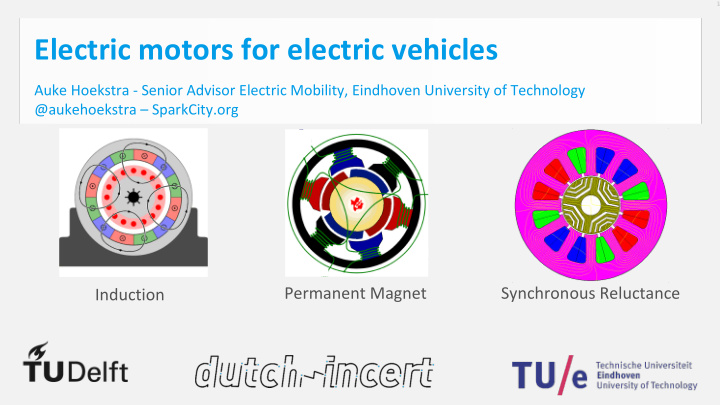



Electric motors for electric vehicles Auke Hoekstra - Senior Advisor Electric Mobility, Eindhoven University of Technology @aukehoekstra – SparkCity.org Permanent Magnet Synchronous Reluctance Induction
What is the best motor for your EV project? Many different angles: • Electrotechnical • Mechanical • Practical • Economic • Environmental
Only three types of motors for EVs L. Kumar and S. Jain, “Electric propulsion system for electric vehicular technology: A review,” Renew. Sustain. Energy Rev. , vol. 29, pp. 924–940, Jan. 2014. Induction Permanent Magnet Synchronous Reluctance Ford ECOstar (1992) Nissan Al tra (1997) Holden Ecommodore (2007) Ford Ranger EV (1999) Toyota Prius (2004) Renault Fluence ZOE (2011) GM EVI (1999) Mitsubishi Miev (2009) Tesla Roadster (2008) Nissan Leaf (2010) Ford Think City (2008) Tata Indica Vista EV (2011) Fiat Panda (2009) Fiat Peogeot ION (2011) Chevrolet Silverado (2010) Chevrolet Volt (2011) Ford Focus Electric (2011) Hyundai Blueon (2012) REVA NXR (2011) Honda Fit EV (2012) Tesla Model S (2012) Honda Civic (2013) Honda Fit EV (2012) Volkswagen eGolf (2015) Toyota Reva 4 (2012) Chevrolet Bolt (2017) Mahindra Reva e20 (2012) Tesla Model 3 (2017)
Brushed DC motor • The classic electric motor • Movement is sustained by switching polarity using Image source: Electric motor – Abnormaal, Wikipedia commutator connected by brushes • Brushes can cause sparks and malfunctions and need regular replacements • No longer used in EVs
Induction Motor How it works Image source: Asynchron motor animation – Burnsburnsburns, Wikipedia Magnetic field in the stator from • electrified windings Through induction the rotor is • magnetized and aligns to stator By alternating current the stator can • produced rotating magnetic field (RMF) that is followed by rotor Rotor is always lagging behind a bit: • this “slip” means it’s an asynchronous motor
Induction motor Image source: Liquid cooling pumps, hydro station L’ange Gardien – Ceedub13, Wikipedia Applications • Used in 90% of industrial motors • Variable frequency drive (VFC) makes speed control easy • Used in the Tesla Roadster and Model S and X (but not in the Model 3)
Induction Motor Advantages Disadvantages • Simple and rugged • Induced currents in rotor cause losses and heat • No brushes • Not the lightest and most • No permanent magnet compact motor • No position sensor • No starting mechanism • Easy speed control
Permanent Magnet Motor Image source: InstaSPIN™-BLDC Motor Control Solution - Courtesy of Texas Instruments How it works • Rotor is magnetized using permanent magnets • Follows RMF without induced currents (heat, losses) • Synchronous • Often with the rotor outside: out-runner. • Also available with rotor inside: in-runner or interior PM motor
Permanent Magnet Motor Applications • Increasingly used in all kinds of high-performance applications Image source: Tesla Model 3 – Leo Nguyen, Wikipedia • Seems to replace the induction motor in electric vehicles
Permanent Magnet Motor Advantages Disadvantages • Light and small Needs: • Silent • Permanent magnets (cost + environment + can • Efficient demagnetise) (especially at lower speeds) • Position sensor • Starter mechanism • Electronic controller
Synchronous Reluctance Motor How it works Image source: Synchronous Reluctance Motor – Technelec, technelec.co.uk • Similar to permanent magnet motor but with steel rotor • Steel rotor design aligns itself to the flux lines of the magnetic field
Synchronous Reluctance Motor Advantages Disadvantages • Torque comparable to • Lower efficiencies at lower permanent magnet motor speeds • Efficient at higher speeds • Higher inherent noise and torque ripple (but increasingly • Cheap and clean to dampened by advanced produce (no permanent controllers) magnets)
Final Motor Comparison L. Kumar and S. Jain, “Electric propulsion system for electric vehicular technology: A review,” Renew. Sustain. Energy Rev., vol. 29, pp. 924–940, Jan. 2014. 5.5 5 4.5 4 Synchronous Reluctance Permanent Magnet 3.5 Induction Brushed 3 2.5 2 Reliability Cost Size and weight Efficiency Speed range Potential for improvement
Thank you for your attention
Recommend
More recommend